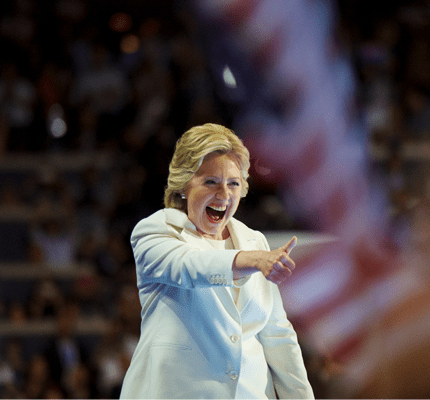
Hillary Clinton: Both a “Witch” and a “Pioneer,” According to Local Newspapers
Despite declines in subscriptions for many years, local news outlets still serve as important sources of information for many people. Local news narratives may differ from those of national media and may reflect the paper’s community better than national sources.
In a new article published in NCA’s Critical Studies in Media Communication, Carrie Teresa analyzes 12 local newspapers published in battleground counties on July 27, 2016, and July 29, 2016, the day of the first vote at the DNC and the day that Hillary Clinton accepted the nomination, respectively. Teresa looks at how the stories are framed, which refers to “the way in which news discourse is packaged and presented to its audiences in terms of news stories, headlines, and photographs or other visual content.”
Analysis
Teresa found that a few newspapers lacked coverage of the first day of the Convention. What coverage existed in local papers was relatively shallow. “[T]hree of [the newspapers] devoted less than four inches of column space” to the Convention, according to Teresa. And, because Clinton did not appear on stage the first night, coverage often focused on surrogates.
In their July 27 coverage, a few newspapers showed former President Bill Clinton on stage, along with such headlines as “Democrats nominate Clinton” and “Hillary Clinton makes history.” Teresa argues that the framing implies that Bill Clinton was making history, rather than Hillary. Thus, according to Teresa, Hillary Clinton was omitted from coverage of the DNC nomination in these papers.
Teresa argues that other headlines emphasized that Clinton’s victory could be attributed to other people, such as Bernie Sanders. For example, a July 27 News & Observer (Raleigh, North Carolina) headline read, “Clinton wins historic nod—with boost from Sanders.” Teresa argues that this headline and others like it “all suggest the same thing: Hillary Clinton did not win the nomination on her own, calling into question her capability as a leader and consensus-builder.”
In contrast, some papers focused on the diversity of Clinton’s audience, such as including an image of “men and women of different ages and ethnicities enthusiastically wav[ing] ‘Stronger Together’ signs on the floor of the DNC,” which was published in the Cincinnati Enquirer. Teresa argues that while these photographs did not show Clinton, they did show the strength of the coalition that Clinton had built.
Teresa notes that Hillary Clinton has been the subject of “20 years’ worth of scrutiny,” including criticism of the way that Clinton laughs. Critics have called it “Clinton’s Cackle” and compared it to a witch. Thus, Teresa argues that there are negative implications associated with showing Clinton engaging in a laugh or “cackle,” as some newspapers did on both July 27 and 29.
On July 29, when Clinton accepted the nomination, many papers framed it as historic. Historical frames, such as describing a candidate as a “pioneer,” can be positive or negative. However, much of the historical coverage was positive. The News & Observer (Raleigh, North Carolina), published an article with the headline, “Clinton’s Historic Moment: ‘We’ll rise to the challenge.’” Teresa argues that this positive frame perpetuated the masculine language used by Clinton in the nomination acceptance speech. Likewise, the Oakland Press described Clinton’s “steady hand,” another masculine trait, in its headline: “Clinton: Steady hand at ‘moment of reckoning.’”
Conclusion
Teresa argues that some articles used negative framing devices that had persisted throughout Clinton’s career, such as the use of images of the “Clinton cackle,” which framed Clinton as a “witch.” Likewise, some articles seemed to shift authority for the nomination away from Clinton to men, such as Bernie Sanders and Bill Clinton. However, other newspapers showed positive messages, such as those with historic frames. Teresa notes that historical frames and terms related to those frames, such as “pioneer” and “first,” are often applied to candidates who are not white or male. These terms may be positive or negative, but they mark these candidates as deviant from the norm.
According to Teresa, the idea of the presidency as an inherently masculine role has been cultivated over time. Frames and media narratives have contributed to the perception that the presidency is inherently masculine and to the perception that women deviate from this role. Teresa argues that “there is a central double-bind for Clinton and other women in power who are simultaneously either too masculine (and therefore deviant and unfit to lead) or too emotional (and therefore unpredictable and unfit to lead).” These frames and the articles associated with them are among numerous factors that influenced public perception and the outcome of the election.


